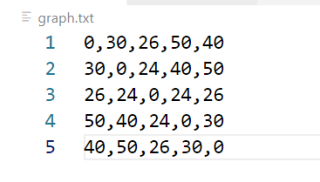已完成,需要在代码的文件夹下新建一个graph.txt,
内容如下

# Python program for Kruskal's algorithm to find
# Minimum Spanning Tree of a given connected,
# undirected and weighted graph
# Class to represent a graph
class Graph:
def __init__(self, vertices):
self.V = vertices # No. of vertices
self.graph = [] # default dictionary
# to store graph
# function to add an edge to graph
def addEdge(self, u, v, w):
self.graph.append([u, v, w])
# A utility function to find set of an element i
# (uses path compression technique)
def find(self, parent, i):
if parent[i] == i:
return i
return self.find(parent, parent[i])
# A function that does union of two sets of x and y
# (uses union by rank)
def union(self, parent, rank, x, y):
xroot = self.find(parent, x)
yroot = self.find(parent, y)
# Attach smaller rank tree under root of
# high rank tree (Union by Rank)
if rank[xroot] < rank[yroot]:
parent[xroot] = yroot
elif rank[xroot] > rank[yroot]:
parent[yroot] = xroot
# If ranks are same, then make one as root
# and increment its rank by one
else:
parent[yroot] = xroot
rank[xroot] += 1
# The main function to construct MST using Kruskal's
# algorithm
def KruskalMST(self):
result = [] # This will store the resultant MST
# An index variable, used for sorted edges
i = 0
# An index variable, used for result[]
e = 0
# Step 1: Sort all the edges in
# non-decreasing order of their
# weight. If we are not allowed to change the
# given graph, we can create a copy of graph
self.graph = sorted(self.graph,
key=lambda item: item[2])
parent = []
rank = []
# Create V subsets with single elements
for node in range(self.V):
parent.append(node)
rank.append(0)
# Number of edges to be taken is equal to V-1
while e < self.V - 1:
# Step 2: Pick the smallest edge and increment
# the index for next iteration
u, v, w = self.graph[i]
i = i + 1
x = self.find(parent, u)
y = self.find(parent, v)
# If including this edge does't
# cause cycle, include it in result
# and increment the indexof result
# for next edge
if x != y:
e = e + 1
result.append([u, v, w])
self.union(parent, rank, x, y)
# Else discard the edge
minimumCost = 0
print("Edges in the constructed MST")
for u, v, weight in result:
minimumCost += weight
print("%d -- %d == %d" % (u+1, v+1, weight))
print("Minimum Spanning Tree", minimumCost)
# Driver code
data = []
with open('graph.txt', mode='r', encoding='utf-8') as fp:
data = fp.readlines()
for i, item in enumerate(data):
data[i] = item.split(',')
n = len(data)
g = Graph(n)
for i in range(n):
for j in range(n):
g.addEdge(i, j, int(data[i][j]))
# Function call
g.KruskalMST()
# This code is contributed by Neelam Yadav

